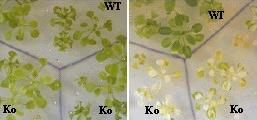Copper is an essential cofactor in the regulation of redox mechanisms, particularly in photosynthetic electron transfer reactions (involving plastocyanin) and detoxification of superoxide radicals (via the Cu/Zn superoxide dismutase). However, when present in excess copper can become toxic. Hence, transport systems can regulate its concentration in the different compartments of the cell. Current knowledge of transport systems involved in ion fluxes into chloroplasts is very limited.
A copper transporter, PA
A1, was already characterized in the chloroplast envelope and is supposed to be the major way to supply copper for photosynthesis. This is a P
1B -type ATPase belonging to a family of proteins involved in the transport of essential metals such as copper, zinc, iron but also in transport of toxic metals such as lead, cadmium. However, inactivation of this transporter does not prevent the import of copper into chloroplasts. There must be another way to import copper into the chloroplast.
Proteomic approaches developed on the chloroplast envelope of Arabidopsis thaliana have permitted the identification of a new transporter: another P
1B -type ATPase, HMA1. Its role as a copper transporter was confirmed by expression in yeast. To better characterize its functions, plants in which the gene encoding HMA1 was either deleted or overexpressed were obtained. The results showed that the deletion of this ATPase leads to a reduction of the chloroplast copper content while no significant variation was found for other metal ions. The growth of these plants is similar to that of unmodified plants. However, these mutants exhibit sensitivity to high light exposure compared to control plants resulting in a partial or total bleaching of leaves. This phenotype is not restored by the addition of copper into the medium.
The two systems using copper in the chloroplast were then analyzed. No change was observed for the plastocyanin, however a strong decrease in superoxide dismutase activity was measured in the absence of HMA1.

Under higher light intensity, the release of reactive oxygen species is enhanced. In the hma1 mutant, the chloroplast superoxide dismutase activity is reduced and is probably insufficient to reduce the pool of free radicals, causing destruction of chlorophylls and, in turn, inhibition of photosynthesis which results in a partial or total bleaching of leaves.
These results suggest that plastids need different copper transport systems and a tight regulation of these copper delivering pathways to supply photosynthesis and to respond to oxidative stress. PA
A1 could be the major copper transport system into the chloroplasts to supply copper for photosynthesis and HMA1 could represent an alternative pathway essential for the plant under adverse light conditions.